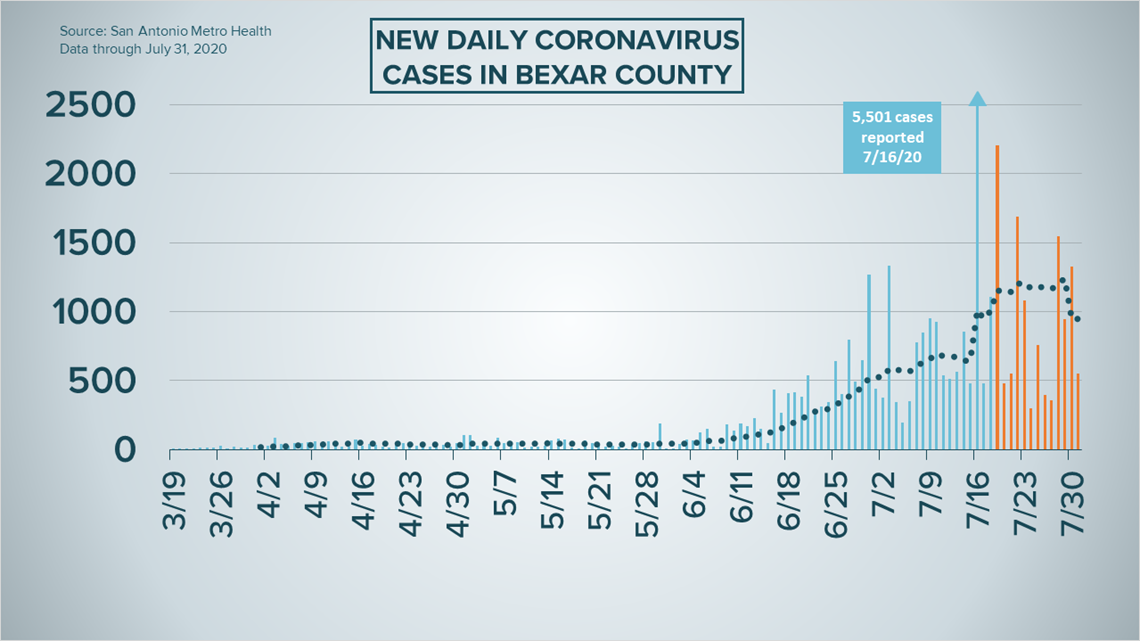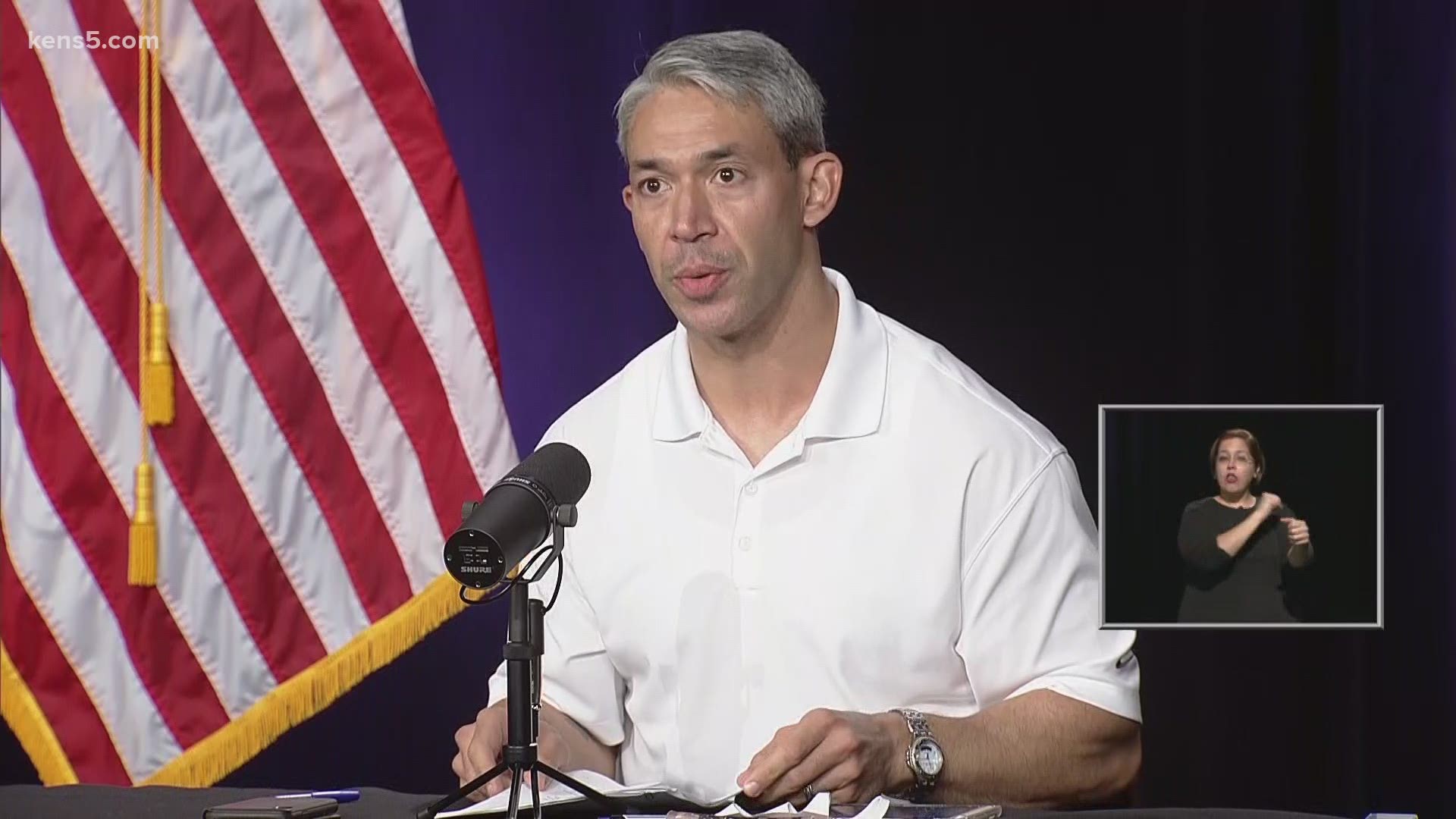SAN ANTONIO — We're tracking the latest numbers from the coronavirus pandemic in San Antonio and across Texas. Here are the latest numbers reported by Bexar and surrounding counties:
- Bexar County: 550 new cases and two additional fatalities from COVID-19 were reported Friday. There have been a total of 40,803 cases as the county death toll rises to 349.
- Comal County: The county reported 14 new cases on Friday, the smallest daily increase in cases since June 11. There have been a total of 2,144 cases and 54 deaths as of Friday afternoon. County officials said there are 936 active coronavirus cases, while 1,154 county residents have recovered.
- Hays County: As of July 31, the Hays County Local Health Department confirms there are at least 2,861 active lab-confirmed cases of COVID-19. Since Hays County first started providing numbers, a total of 4,315 lab-confirmed cases have been reported, including 28 deaths. As of July 31, the Hays County Local Health Department has received 21,521 negative test results. At least 1,426 people have recovered from the virus in Hays County. According to the county, there have been 105 total hospitalizations, with 25 still hospitalized as of July 31.
How Bexar County is trending
We're tracking how many coronavirus cases are confirmed in Bexar County each day from the time San Antonio Metro Health began reporting cases more than five months ago. Graphing those daily case numbers along a 14-day moving average provides an accurate picture of the curve in the San Antonio area and the direction we're heading amid the coronavirus.
On Friday, Mayor Ron Nirenberg reported 550 COVID-19 cases in the county. Meanwhile, Nirenberg said there had been two additional virus-related deaths in the county. The death toll is now up to 349; a total of 40,803 Bexar County residents have contracted the virus.


Hospitalizations in Bexar County continued their downward trend. As of Friday evening, 926 patients remain hospitalized in Bexar County; 364 patients are in the ICU, while 252 patients are on ventilators.
15% of staffed hospital beds in the county are available, while 53% of the county's ventilators are available.


Coronavirus in Texas
State health officials reported 8,839 daily new cases Friday, bring the total number of coronavirus cases in Texas to 420,946.
Following two straight days of record daily fatalities, Texas reported 295 new COVID-19 deaths Friday. There have now been 6,569 total deaths since tracking began in March.


The state also changed its method of collecting death data on Monday of this week, looking at death certificates to count fatalities. Thursday, DSHS officials said an automation error caused deaths to be overreported for July 27, 28, and 29. A "manual check" revealed 225 fatalities had been included in reporting even though COVID-19 was not listed as a direct cause of death.
On July 17, Texas crossed the 300,000 case mark, reporting 307,572 total. Twelve days later, the state crossed the 400,000 mark.
The state's seven-day average positivity rate sits at 12.12%, which means for every eight people tested, at least one tests positive for coronavirus. The positivity rate has been on a downward trend since July 16, when it was 17.43%.
9,336 patients are currently in Texas hospitals, as of Friday. The state estimates 141,186 Texans remain ill with COVID-19, while 273,191 have recovered.
Latest Coronavirus Headlines
- Trump, GOP soften on opposition to $600 unemployment benefit that expires Friday
- Report: MLB commissioner warns of shut down if coronavirus isn't managed better
- New Braunfels nursing home worker shares concerns from the frontline
- US consumer spending up 5.6%, but coronavirus could stall gains
- 'This is something I can do': San Antonians among the first to participate in COVID-19 vaccine trials
- Proper medical care key to safe pregnancy during COVID-19 pandemic
- 'She was the shirt-off-your-back kind of woman': Coronavirus claims the life of Northside ISD cafeteria manager
Coronavirus symptoms
The symptoms of coronavirus can be similar to the flu or a bad cold. Symptoms include fever or chills, cough, shortness of breath or difficulty breathing, fatigue, muscle or body aches, headache, new loss of taste or smell sore throat, congestion or runny nose, nausea or vomiting and diarrhea, according to the Centers for Disease Control.
Most healthy people will have mild symptoms. A study of more than 72,000 patients by the Centers for Disease Control in China showed 80 percent of the cases there were mild.
But infections can cause pneumonia, severe acute respiratory syndrome, kidney failure, and even death, according to the World Health Organization. Older people with underlying health conditions are most at risk.
On June 25, the CDC expanded the list of groups at a higher risk of severe illness due to coronavirus.
Experts determined there was consistent evidence these conditions increase a person's risk, regardless of age:
- Chronic kidney disease
- COPD (chronic obstructive pulmonary disease)
- Obesity (BMI of 30 or higher)
- Immunocompromised state (weakened immune system) from solid organ transplant
- Serious heart conditions, such as heart failure, coronary artery disease, or cardiomyopathies
- Sickle cell disease
- Type 2 diabetes
The CDC believes symptoms may appear anywhere from two to 14 days after being exposed.
Human coronaviruses are usually spread...
- Between people who are in close contact with one another (within about 6 feet).
- Through respiratory droplets produced when an infected person coughs, sneezes or talks. These droplets can land in the mouths or noses of people who are nearby or possibly be inhaled into the lungs.
- Some recent studies have suggested that COVID-19 may be spread by people who are not showing symptoms.
Help stop the spread of coronavirus
- Stay home when you are sick.
- Eat and sleep separately from your family members
- Use different utensils and dishes
- Cover your cough or sneeze with your arm, not your hand.
- If you use a tissue, throw it in the trash.
Lower your risk
- Wash your hands often with soap and water for at least 20 seconds. If soap and water are not available, use an alcohol-based hand sanitizer.
- Avoid touching your eyes, nose, and mouth with unwashed hands.
- Avoid close contact with people who are sick.
- Clean and disinfect frequently touched objects and surfaces.
- The CDC recommends wearing a mask or cloth face covering if you have to be out due to an essential service or essential activity such as going to the grocery store.
- If you are 60 or over and have an underlying health condition such as cardiovascular disease, diabetes or respiratory illnesses like asthma or COPD, the World Health Organization advises you to try to avoid crowds or places where you might interact with people who are sick.

